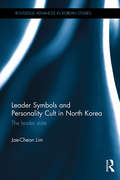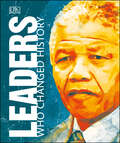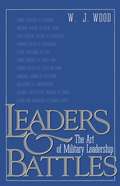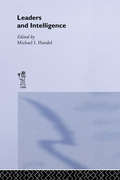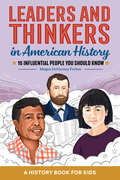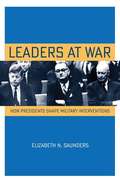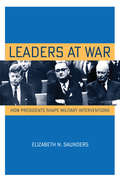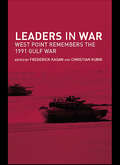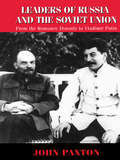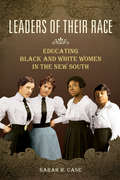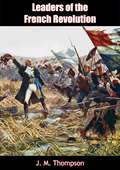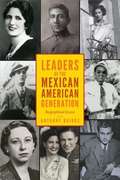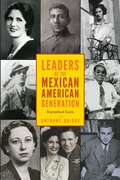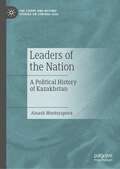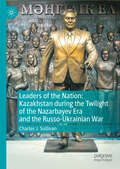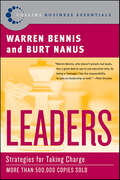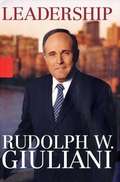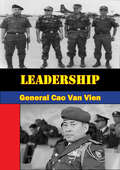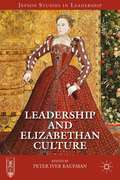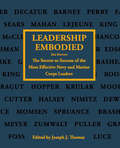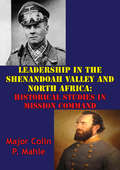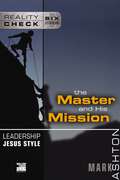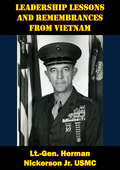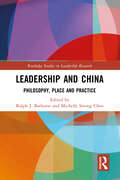- Table View
- List View
Leader Symbols and Personality Cult in North Korea: The Leader State (Routledge Advances in Korean Studies)
by Jae-Cheon LimThe legitimacy of the North Korean state is based solely on the leaders’ personal legitimacy, and is maintained by the indoctrination of people with leader symbols and the enactment of leadership cults in daily life. It can thus be dubbed a "leader state". The frequency of leader symbols and the richness and scale of leader-symbol-making in North Korea are simply unrivalled. Furthermore, the personality cults of North Korean leaders are central to people’s daily activity, critically affecting their minds and emotions. Both leader symbols and cult activities are profoundly entrenched in the institutions and daily life, and if separated and cancelled, the North Korean state would be transformed. This book analyses North Korea as a "leader state", focusing on two elements, leader symbols and cult activities. It argues that these elements have been, and continue to be, the backbone of North Korea, shaping North Korean culture. To reveal the "leader state" character, the book specifically examines North Korea’s leadership cults, its use of leader symbols in these cults, and the nature of the symbolism involved. How has the North Korean state developed the cult of the Kim Il Sung family? How does the state use leader symbols to perpetuate this cult? How has the state developed myths and rituals that sustain the cult in daily life? What leader images has state propaganda manufactured? How does the state’s manipulation of leader symbols affect the symbolism that is assigned to the leader’s actions? In answering these questions, this book sheds new light on the strength and resilience of the North Korean state, and shows how it has been able to survive even the most difficult economic period of the mid-1990s. Leader Symbols and Personality Cult in North Korea will be essential reading for students and scholars of North Korea, Korean politics, Asian politics, political sociology and visual politics.
Leaders Who Changed History (DK People Who Changed History)
by DKExplore the lives of more than 85 of the world's most transformational and influential leaders in politics, business, religion, humanitarianism, and the military with this innovative and boldly graphic book.Comprehensive in its scope and depth, and fully illustrated, Leaders Who Changed History profiles leaders from inspirational to insidious, those who changed the world for the better and those whose corruption left enduring scars. These figures hail from all walks of life - including political, military, religious, and business. Combining accessible text with specially commissioned illustrated portraits in a range of bold styles, photographs, infographics, and timelines, entries explore the lives and legacies of each individual in a fresh, visual way. Covering political masterminds and military geniuses such as Alexander the Great and Genghis Khan, great kings and queens like Elizabeth I and Catherine the Great, icons of religion and rebellion from Mohammad to the Dalai Lama to Mahatma Ghandi, and captains of industry, Leaders Who Changed History explores and explains the world-changing actions of history's heroes and villains.
Leaders and Battles: The Art of Military Leadership
by W. J. WoodIn a time when leadership is confused with management, W. J. Wood reminds us that the true determinant of military leadership is on the battlefield. --Harry Summers, author of On Strategy
Leaders and Intelligence (Studies in Intelligence)
by Michael I. HandelFrom a systematic point of view, all intelligence work can be studied on three levels: Acquisition, analysis, and acceptance. The author focuses on the third of these levels, studying the attitudes and behavioural patterns developed by leaders during their political careers, their willingness to consider information and ideas contrary to their own, their ability to admit mistakes and change course in the implementation of a failing policy and their capacity to cooperate.
Leaders and Thinkers in American History: 15 Influential People You Should Know (Biographies for Kids)
by Megan DuVarney ForbesInspiring stories of American heroes throughout history—for kids ages 8 to 12 George Washington's life illustrates the very first values that American politicians shared. The story of Tecumseh teaches us about the power of being true to yourself and defending your community. Lucretia Mott shows us how to stand up against what is wrong and speak out for what is right. Leaders and Thinkers in American History is a colorful children's history book that explores the lives of influential American figures and their incredible accomplishments. Kids will discover the stories of men and women across hundreds of years, from all different backgrounds, and how they used their passion and talent to impact the world. Go beyond other American history books with: 15 detailed biographies—Kids will learn that the history of the United States is full of fascinating and impressive people who pioneered everything from politics to technology, music, and art. Learn and grow—These powerful stories will inspire kids to find their own gifts and use them to help others and achieve their dreams. Beyond this book—For kids who want to learn even more, each biography includes suggestions for further reading and tips for getting active in their community. Get kids excited about history with a children's history book featuring extraordinary Americans from all walks of life.
Leaders at War: How Presidents Shape Military Interventions
by Elizabeth N. SaundersOne of the most contentious issues in contemporary foreign policy—especially in the United States—is the use of military force to intervene in the domestic affairs of other states. Some military interventions explicitly try to transform the domestic institutions of the states they target; others do not, instead attempting only to reverse foreign policies or resolve disputes without trying to reshape the internal landscape of the target state. In Leaders at War, Elizabeth N. Saunders provides a framework for understanding when and why great powers seek to transform foreign institutions and societies through military interventions. She highlights a crucial but often-overlooked factor in international relations: the role of individual leaders. Saunders argues that leaders' threat perceptions—specifically, whether they believe that threats ultimately originate from the internal characteristics of other states—influence both the decision to intervene and the choice of intervention strategy. These perceptions affect the degree to which leaders use intervention to remake the domestic institutions of target states. Using archival and historical sources, Saunders concentrates on U.S. military interventions during the Cold War, focusing on the presidencies of Eisenhower, Kennedy, and Johnson. After demonstrating the importance of leaders in this period, she also explores the theory's applicability to other historical and contemporary settings including the post–Cold War period and the war in Iraq.
Leaders at War: How Presidents Shape Military Interventions (Cornell Studies in Security Affairs)
by Elizabeth N. SaundersOne of the most contentious issues in contemporary foreign policy—especially in the United States—is the use of military force to intervene in the domestic affairs of other states. Some military interventions explicitly try to transform the domestic institutions of the states they target; others do not, instead attempting only to reverse foreign policies or resolve disputes without trying to reshape the internal landscape of the target state. In Leaders at War, Elizabeth N. Saunders provides a framework for understanding when and why great powers seek to transform foreign institutions and societies through military interventions. She highlights a crucial but often-overlooked factor in international relations: the role of individual leaders. Saunders argues that leaders’ threat perceptions—specifically, whether they believe that threats ultimately originate from the internal characteristics of other states—influence both the decision to intervene and the choice of intervention strategy. These perceptions affect the degree to which leaders use intervention to remake the domestic institutions of target states. Using archival and historical sources, Saunders concentrates on U.S. military interventions during the Cold War, focusing on the presidencies of Eisenhower, Kennedy, and Johnson. After demonstrating the importance of leaders in this period, she also explores the theory’s applicability to other historical and contemporary settings including the post–Cold War period and the war in Iraq.
Leaders in War: West Point Remembers the 1991 Gulf War (Cass Military Studies)
by Frederick W. Kagan Major Chris KubikLeaders in War present unique first-person perspectives across the spectrum of American combat operations during the 1991 Persian Gulf War. From division commanders to platoon leaders, the authors deliver an insider's view of tough leadership challenges, tragic failures, and triumphant victories. Leaders in War captures the essence of the post-Cold
Leaders of New York's Industrial Growth (Spotlight on New York)
by James BernardIntroduces major developments in the economic history of New York and describes the growth of railroads, the Brooklyn Bridge, glassmaking, oil, electricity, finance, and other industries and the accomplishments of some of the people involved.
Leaders of Russia and the Soviet Union: From the Romanov Dynasty to Vladimir Putin
by John PaxtonThis reference work surveys the leaders of Russia and the Soviet Union- from Michael, the first Romanov tsar in 1613, through the creation and dissolution of the Soviet Union, to the present day President of the Russian Federation, Vladimir Putin. Chronologically arranged, these biographies paint a thorough yet succinct portrait of 30 leaders including discussion about the family and education of each ruler, important legislation, events, and wars under each leader's rule; and each leader's achievements and impact on Russia or the Soviet Union.
Leaders of Their Race: Educating Black and White Women in the New South (Women, Gender, and Sexuality in American History)
by Sarah H. CaseSecondary level female education played a foundational role in reshaping women's identity in the New South. Sarah H. Case examines the transformative processes involved at two Georgia schools--one in Atlanta for African-American girls and young women, the other in Athens and attended by young white women with elite backgrounds. Focusing on the period between 1880 and 1925, Case's analysis shows how race, gender, sexuality, and region worked within these institutions to shape education. Her comparative approach shines a particular light on how female education embodied the complex ways racial and gender identity functioned at the time. As she shows, the schools cultivated modesty and self-restraint to protect the students. Indeed, concerns about female sexuality and respectability united the schools despite their different student populations. Case also follows the lives of the women as adult teachers, alumnae, and activists who drew on their education to negotiate the New South's economic and social upheavals.
Leaders of the French Revolution
by J. M. Thompson1789-1795 were years of revolutionary drama in France—of struggle protest, war-fever, exasperation, terror, ambition and bloodshed. Few of the many who are remembered from the time were great men, but they lived under the microscope of great times, which gave to their most insignificant qualities portentous proportions. Perhaps, too, their age and country encouraged variety and extravagance of character, few there are few periods of history so rich in personalities.Of the eleven men chosen by J. M. Thompson for study, only three (Sieyès, Lafayette and Dumouriez) survived the Revolution, and lived to see its cynical apotheosis in the Napoleonic Empire. Of the others, Mirabeau died in 1791 and Louvet in 1797, while the remainder—Brissot, Marat, Danton, Fabre, Robespierre and St. Just—were murdered, executed or put to death.J. M. Thompson writes in his introduction, ‘But to all of them the Revolution was an overwhelming experience. What did they do in it? What did they think of it? Let us see.’
Leaders of the Mexican American Generation
by Anthony QuirozLeaders of the Mexican American Generation explores the lives of a wide range of influential members of the US Mexican American community between 1920 and 1965 who paved the way for major changes in their social, political, and economic status within the United States. Including feminist Alice Dickerson Montemayor, San Antonio attorney Gus García, civil rights activist and scholar Ernesto Galarza, the subjects of these biographies include some of the most prominent idealists and actors of the time. Whether debating in a court of law, writing for a major newspaper, producing reports for governmental agencies, organizing workers, holding public office, or otherwise shaping space for the Mexican American identity in the United States, these subjects embody the core values and diversity of their generation. More than a chronicle of personalities who left their mark on Mexican American history, Leaders of the Mexican American Generation cements this community as a major player in the history of activism and civil rights in the United States. It is a rich collection of historical biographies that will enlighten and enliven our understanding of Mexican American history.
Leaders of the Mexican American Generation: Biographical Essays
by Anthony QuirozLeaders of the Mexican American Generation explores the lives of a wide range of influential members of the US Mexican American community between 1920 and 1965 who paved the way for major changes in their social, political, and economic status within the United States. Including feminist Alice Dickerson Montemayor, to San Antonio attorney Gus García, and labor activist and scholar Ernesto Galarza, the subjects of these biographies include some of the most prominent idealists and actors of the time. Whether debating in a court of law, writing for a major newspaper, producing reports for governmental agencies, organizing workers, holding public office, or otherwise shaping space for the Mexican American identity in the United States, these subjects embody the core values and diversity of their generation. More than a chronicle of personalities who left their mark on Mexican American history, Leaders of the Mexican American Generation cements these individuals as major players in the history of activism and civil rights in the United States. It is a rich collection of historical biographies that will enlighten and enliven our understanding of Mexican American history.
Leaders of the Nation: A Political History of Kazakhstan (The Steppe and Beyond: Studies on Central Asia)
by Ainash MustoyapovaThe book tells about people who lived in an era of historical cataclysms, wars and revolutions, changes in political formations. The generation of the Kazakh intelligentsia responded to the historical challenge facing the Kazakhs at a turning point in history. These are people born at the end of the 19th century, educated in different countries and united by the idea of overcoming colonial dependence on the Russian Empire.The author aims to form a holistic view of a galaxy of outstanding personalities who, in an important historical period, were able to take responsibility for the people and their future. The history of the country is perceived through the prism of their destinies, views, activities and death.The material of the book is a biographical sketch and covers the history of Kazakhstan in the first third of the twentieth century, until the period of the Great Terror (1937–1938).
Leaders of the Nation: Kazakhstan during the Twilight of the Nazarbayev Era and the Russo-Ukrainian War
by Charles J. SullivanThis book provides an overview of the major developments in Kazakhstan over the past decade. In analyzing a series of challenges (such as the need on behalf of the current Kazakh president – Kassym-Jomart Tokayev – to restore legitimacy in the government in the aftermath of "Bloody January" as well as Astana’s managing of relations with Russia, China, and the West), this book offers readers a timely understanding concerning how power has been wielded, mishandled, and reasserted in this country. This book explores the achievements of Kazakhstan’s modernization drive, the government’s prolonged initial political transition, the rise of a local civil society, the events of January 2022, and Kazakhstan’s relations with Russia and the West. Written by a political scientist who previously worked at the country’s flagship university, Leaders of the Nation: Kazakhstan during the Twilight of the Nazarbayev Era and the Russo-Ukrainian War outlines why Kazakhstan warrants our earnest attention.
Leaders: The Strategies for Taking Charge (Collins Business Essentials)
by Warren Bennis Burt Nanus“An insightful book that should be read by every manager aspiring to be a true leader. . . . One of the most important books of its type” (Chicago Tribune).In this illuminating study of corporate America’s most critical issue—leadership—world-renowned leadership guru Warren Bennis and his co-author Burt Nanus reveal the four key principles every manager should know: Attention Through Vision, Meaning Through Communication, Trust Through Positioning, and The Deployment of Self.In this age of “process,” with downsizing and restructuring affecting many workplaces, companies have fallen trap to lack of communication and distrust, and vision and leadership are needed more than ever before. The wisdom and insight in Leaders address this need. It is an indispensable source of guidance all readers will appreciate, whether they’re running a small department or in charge of an entire corporation.“One of the top fifty business books of all time.” —Financial Times“At a time when corporations need fewer managers to hold things in place and more leaders to guide change, this book provides a valuable addition to an executive’s repertoire.” —Rosabeth Moss Kanter“All American managers should listen closely to this message and act! Warren Bennis and Burt Nanus have written a masterpiece, a thriller. . . . We owe these two men a debt of gratitude.” —Tom Peters
Leadership
by Ken Kurson Rudolph W. GiulianiHaving inherited a city ravaged by crime and crippled in its ability to serve its citizens, Giuliani shows how he found that every aspect of his career up to that point-from clerking for the formidable judge who demanded excellence (and rewarded it with a lifetime of loyalty) to busting organized crime during his years as a federal attorney -shaped his thinking about leadership and prepared him for the daunting challenges ahead. Giuliani's successes in turn strengthened his conviction about the core qualities required to be an effective leader, no matter what the size of the organization, be it an international corporation or a baseball team. In detailing his principles of leadership, Giuliani tells captivating stories that are personal as well as prescriptive.
Leadership (Indochina Monographs #11)
by General Cao Van VienThis monograph forms part of the Indochina Monograph series written by senior military personnel from the former Army of the Republic of Vietnam who served against the northern communist invasion.War and politics posed many challenges to South Vietnam's military leadership. Unlike his counterpart in some countries, the Vietnamese military commander was not simply a leader of men in combat. Depending on the level of command, he had to play his part in national politics, be himself a grass roots politician, or engage in political warfare. To achieve success, he was often expected to possess several qualities not always required of a professional military leader. The requirements of leadership, therefore, sometimes transcended the conventional framework of accepted rules and principles.Given these requirements and the fallibility of human nature, it had not always been easy to evaluate the total performance of our leadership. The dilemma we faced was that while professional competence during actual combat was a critical criteria, we could not tolerate deliberate aberrations in moral and social codes.In my analysis of the successes and failures of our leadership, I have endeavored to be fair and objective. If I seem to be laudatory of some officers while critical of others, it is not my intention to embarrass any individual. Performance has been the sole basis for all of my evaluations.
Leadership And Elizabethan Culture
by Peter Iver KaufmanLeadership an Elizabethan Culture studies the challenges confronted by government and church leaders (local and central), the counsel given them, the consequences of their decisions, and the views of leadership circulating in late Tudor literature and drama.
Leadership Embodied
by Joseph ThomasNow in its second edition, Leadership Embodied is an instructive collection of short biographical essays focusing on Navy and Marine Corps personnel, who have demonstrated notable leadership characteristics. While leaders are present in every aspect of human undertaking, leadership in this work is illustrated through the most dramatic and demanding of all human undertakings-war and the preparations for war. Wartime challenges are, because of the life and death nature of the affair, more monumental and exacting. All of these individuals have been selected because they dramatically shaped today's institutions, practices, and customs within the naval services. The contributions of these individuals should be required reading for any student of leadership because they each demonstrate a particular lesson for midshipmen on their journey to becoming a navy or Marine Corps officer.
Leadership In The Shenandoah Valley And North Africa: Historical Studies In Mission Command
by Major Colin P. MahleMission command, as outlined in Army Doctrine Reference Publication (ADRP) 6-0, Mission Command, is the contemporary philosophy through which army commanders combine mission, intent, and subordinate initiative to win in unified land operations. Though not known to them as mission command, prominent leaders such as Field Marshal Erwin Rommel and Major General Thomas J. "Stonewall" Jackson used similar concepts.This study specifically examines how these leaders employed three of the six principles outlined in current mission command doctrine. They are: (1) build cohesive teams through mutual trust, (2) exercise disciplined initiative, and (3) provide a clear commander's intent. Determining the methods that these commanders employed during their celebrated campaigns through the framework of mission command highlights characteristics that will benefit military leaders at all levels. The linkages between these historical campaigns and current mission command philosophy are the focus of this study.
Leadership Jesus Style: The Master and His Mission (Reality Check)
by Mark AshtonThe Reality Check series makes just one assumption: that you’re serious enough about your spiritual journey to investigate Christianity with an open mind. This isn’t about joining anyone’s religious club—it’s about being real with yourself and with the others in your group. Since no one has all the answers, there’s plenty of room for discussion. After all, if there is any truth to the Bible’s stories about Jesus, then one thing he’d welcome are questions and opinions that come from honest, earnest hearts.Whether you’re leading a corporation, a sports team, your family, or simply your own pursuits, issues such as mission, character, vision casting, and team building are critical to your success. Wouldn’t it be great to take lessons from a master leader? Here’s your opportunity. Nobody in history has surpassed Jesus of Nazareth in either methods or results. Find out his leadership secrets. They’re guaranteed to make you a better leader.Leadership Jesus Style includes these sessions: Upside-Down Leadership What’s Your Mission? Casting a Vision The Master Strategist Building a Team When Others FailFor the Group LeaderReality Check is for spiritual seekers of every persuasion. Uncompromisingly Christian in its perspective, it steers wide of pat answers and aims at honesty. This innovative and thought-provoking series will challenge you and those in your group to connect heart to heart as together you explore the interface between Jesus, the Bible, and the realities of this world in which we live.
Leadership Lessons And Remembrances From Vietnam
by Lt.-Gen. Herman Nickerson Jr. USMCIn view of his unique experiences as a senior Marine commander in Vietnam and his Extensive efforts to communicate his views and his combat knowledge to the troops he commanded, it was decided to republish a series of articles that Lieutenant General Herman Nickerson, Jr., wrote in 1969-1970 while he was Commanding General, III Marine Amphibious Force (III MAF), which were published in Sea Tiger; the weekly newspaper distributed throughout the III MAF area of northern South Vietnam. General Nickerson commanded the 1st Marine Division in Vietnam from 1 October 1966 to 31 May 1967 and returned to that embattled country to command the III MAF from 27 March 1969 through 9 March 1970. During this latter tour of duty, in order to make up in part for an in-person briefing and welcome he used to give incoming officers and staff non-commissioned officers of the 1st Division, he began writing a series of articles for publication in Sea Tiger. In these short pieces, he covered a wide range of topics, some related to combat service in Vietnam, but many more to the Vietnamese people and the role of Americans in their support.
Leadership and China: Philosophy, Place and Practice (Routledge Studies in Leadership Research)
by Ralph J. Bathurst Michelle Sitong ChenSince its opening in 1978, China has undergone radical change. By establishing special economic zones along its Eastern coastal borders under Deng Xioping’s tutelage, China entered the global market. Loosening controls from central government allowed for a more free-market approach that facilitated easier trading partnerships across national boundaries. Leadership and China: Philosophy, Place and Practice explores the impact of these changes today. Companies across the globe are doing business with Chinese counterparts, but recently the Western world has begun treating China with suspicion, with some commentators claiming nefarious aims on the part of Chinese Communist Party, and intentions of favoring China’s growing middle class and political elites, while impoverishing other international trading partners. This calls for wise leadership on both sides of the political divide and this book facilitates conversations that explore synergies between East and West, aiming to move past suspicion and discuss how leaders might work for the benefit of all humanity. With an orientation towards conversations rather than polemics, graduate students, scholars and business leaders across the globe will benefit from this book.
